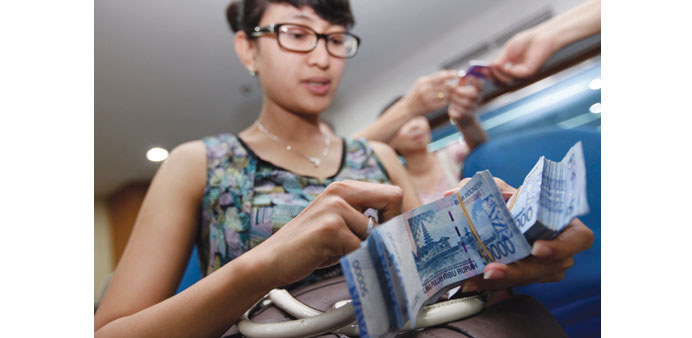A woman counts Indonesian rupiah at a money changer in Jakarta. Indonesia’s dollar bonds have lost 1% this year, compared with a 0.4% drop for Malaysian notes and 3.4% gain for Philippine securities, according to JPMorgan Chase & Co indexes.
Bloomberg
Singapore
Indonesia raised $3.5bn in its second sovereign dollar bond sale of 2015, preempting a likely increase in US borrowing costs.
The government sold $2.25bn of 10-year notes at 4.8% and $1.25bn of 30-year securities at 6%, Scenaider Siahaan, a director at the Finance Ministry’s budget financing and risk management office, said in a text message yesterday. Bids totalled $8.1bn, he said.
The yields were higher than in the secondary market where dollar bonds due January 2025 yielded 4.57% as of 3:41 pm in Jakarta and those due January 2045 yielded 5.65%, data compiled by Bloomberg show.
Indonesian authorities said last month they were planning another dollar sale in 2015 to raise money for next year’s budget, and futures contracts show a 72% chance the Federal Reserve will hike interest rates this month. The government will increase the share of foreign-currency debt to 30% of total issuance in 2016 from 24% this year to guard against potential increases in local-currency yields as the US raises rates, Robert Pakpahan, director-general at the budget financing office in Jakarta, said November 12.
“The sale is a well-timed move,” said Tim Condon, head of Asia research at ING Groep NV in Singapore. Indonesia “would have raised the yield if they had difficulty selling the bonds. Obviously they got a lot of demand,” he said.
The yields were lower than the indicative levels of 5% and 6.125% that came on Tuesday from a person familiar with the offer who asked not to be identified because he or she wasn’t authorised to speak publicly on the matter.
Indonesia last sold dollar bonds in January, issuing $4bn of 10- and 30-year notes at coupons of 4.125% and 5.125%, respectively. Proceeds from this week’s sale will bolster the central bank’s foreign-exchange reserves, which have fallen 10% to $100.7bn this year through October.
“The country wants to pre-fund ahead of a potential Fed liftoff,” Avanti Save, a credit strategist at Barclays in Singapore, said on Tuesday. “Compared to global emerging-market peers, Indonesia has stronger credit metrics and credit ratings are expected to remain stable.”
Some 62% of the 10-year bonds were bought by investors in the US, 14% went to Europe, 10% to Asia excluding Indonesia and 14% to domestic buyers, the Finance Ministry said in a statement. Around 50% of the 30- year notes went to the US, 26% to Europe, 22% to Asia and 2% to Indonesia. By investor type, asset managers had the biggest share for each tenor at more than 70%.
The sale was the largest dollar-denominated issuance by an emerging-market sovereign this half after Kazakhstan’s $4bn offer in July, data compiled by Bloomberg show.
The sale was part of the nation’s $40bn global-medium term note programme, which was expanded by $10bn this week. Standard & Poor’s said on Tuesday it would retain its rating of BB+, the highest junk level, for Indonesia after it enlarged the programme.
The rating has a positive outlook, indicating the possibility of an upgrade over the next 12 months if the government achieves more reforms such as allowing fuel prices to adjust more freely, S&P said in a statement.
Moody’s Investors Service and Fitch Ratings assess Indonesia at the lowest investment grade.
“Given their borrowings are relatively light already, we think that even if they go to the limit of this programme it’s not going to really affect their credit rating,” said Kyran Curry, S&P’s director of sovereign ratings in Singapore.
Indonesia’s dollar bonds have lost 1% this year, compared with a 0.4% drop for Malaysian notes and 3.4% gain for Philippine securities, according to JPMorgan Chase & Co indexes.

